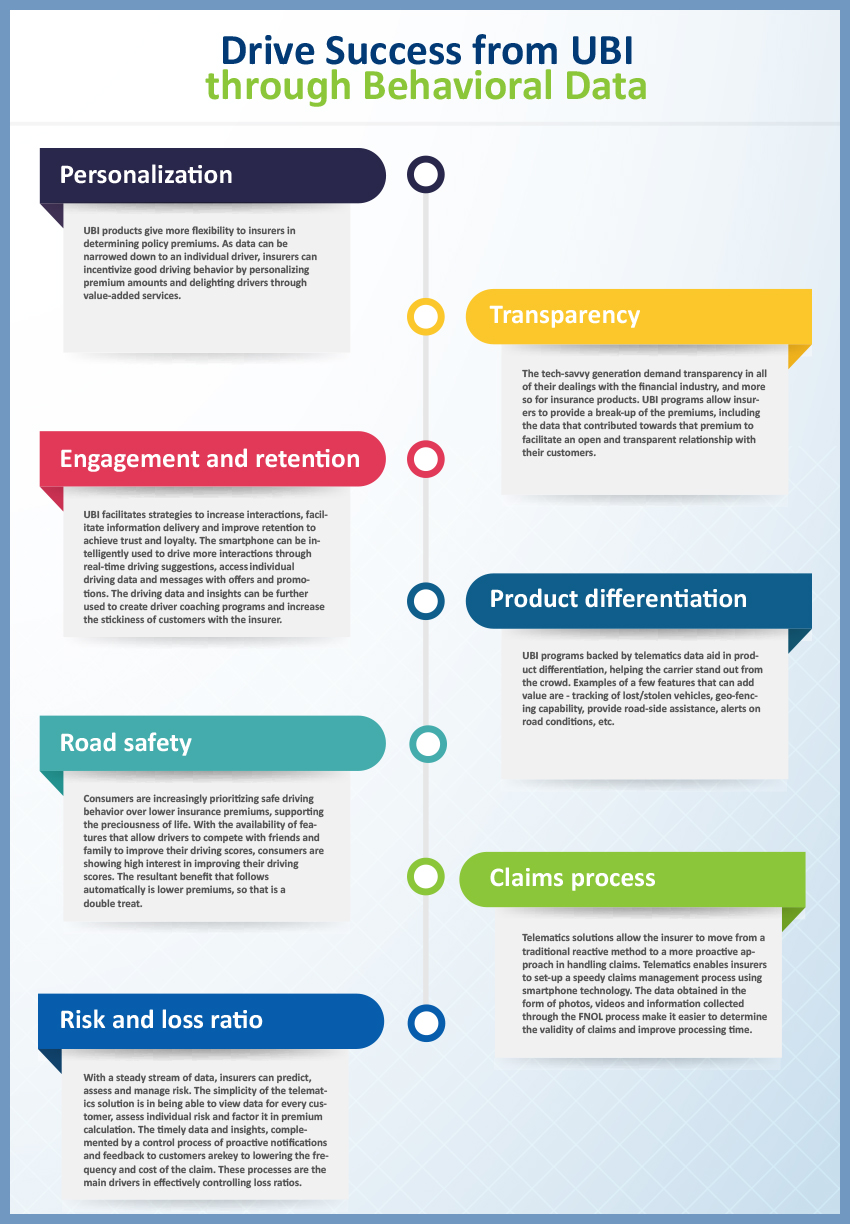29 Aug / Author: SK Tirumala
UBI is gaining momentum with wider acceptance of telematics data
Mobile devices are revolutionizing how telematics data is captured
The humble beginnings of UBI
About a decade ago, a handful of traditional insurance companies began to innovate and offer usage-based insurance (UBI) programs in the U.S. These programs offered mileage-linked discounts by utilizing a combination of GPS technology and cellular systems that tracked miles driven. The next evolution was to directly tap into the vehicle’s OBD port and get more reliable trip data along with vehicle diagnostics that provided a larger data set to redefine appetite and enhance products. Fast forward to now, UBI programs have started to rely heavily on telematics solutions that have expanded their data capture including reporting on real-time driving habits (behavioral telematics) of policyholders.
To comprehensively assess a risk, insurers can now count on cost-effective solutions that capture not just the mechanical metrics, but also the data related to exposures caused by individual driving habits like phone distractions, speeding, unsafe turns, etc. Telematics-enabled UBI allows underwriters and analysts to collect this ever-increasing amount of real-time driving information and come up with tailor-made insurance products and competitive pricing models for their target markets. This led to the growth of several UBI products such as Pay-As-You-Drive (PAYD), Pay-How-You-Drive (PHYD), and so on.
Embrace Telematics-led revolution across the value chain
Telematics data was ignored from the underwriting standpoint at first due to the lack of conclusive evidence of a correlation between driving behavior and loss ratios (or profitability), based on which pricing decisions could be made. Data then was not dependable because user adoption was poor, technology was new, and the information gathered was insufficient. It is no longer the case. The rapid evolution of technology, advanced telematics solutions, and a greater appetite of the end user to share their data, has opened doors to an incredible amount of information being available that can be converted into actionable business strategies. Data scientists have uncovered new conclusive evidence that improvement in driving habits does impact the bottom line, and that it should be a part of the overall risk assessment.
Carriers today are under more pressure to reinvent insurance products that meet the changing needs of consumers while trying to remain profitable and competitive. Timing is perfect! Solutions based on telematics technology are now delivering deeper insights into risks, with behavioral trends, new scores, and predictive indicators that allow pricing of policies to suit and fit individual needs at competitive premiums. Mobile device-based telematics is gaining a huge momentum as this platform solves the chronic adoption issues, in addition to serving as a channel to advance a digital transformation agenda.
Even during the claims adjudication process, telematics data is playing a major role in claims settlement with greater efficiency, without risking customer satisfaction and loyalty. Innovation is at its peak with a variety of solutions and methods that can capture relevant data for loss event analysis.
The UBI predictions
America is the largest auto insurance market in the world with currently 5 million UBI policies in force. According to a report from IHS Automotive, close to 12 million consumers globally subscribed to UBI and this is expected to grow to 142 million globally by 2023. A Tower Watson survey shows that more than 88% of Millennials are interested in taking out a UBI policy, versus 74% among all other age groups, making it a more popular product among the growing younger generation.

Ride the UBI wave to stay relevant
The underwriting side was typically the entry point for telematics programs. Telematics offers a broad set of opportunities to insurers to identify specific opportunities or improve their existing processes. Telematics creates value for the insurance business in the following five areas: Risk selection, Risk-based pricing, Value-added services, Loss control, Loyalty and driving behavior improvement programs.
In the years to come, underwriters of personal and commercial auto lines will face an increasing pressure to come up with products that match the pace of technology advancements. As the telematics-based UBI revolution evolves, insurance carriers that still want to stick with non-UBI products may face problems arising from poor underwriting performance, inefficient administration and higher chances of fraudulent claims. This will subsequently lead to slow decision-making processes, which affect customer service and sustainability, resulting in poor customer retention.
Ride the Digital wave at the Connected Car Insurance USA 2017
Harness the power of data
Underwriters who are already utilizing real-time driving data, Big Data and IoT to design UBI products, have only seen the tip of the iceberg. There is immense potential in data to enable revolutionary auto insurance products of the future. However, it has been projected that only 36% of insurers may use UBI by 2020. To stay ahead of the game, it is crucial that underwriters leverage data to create products which are profitable to the insurer and their consumers.